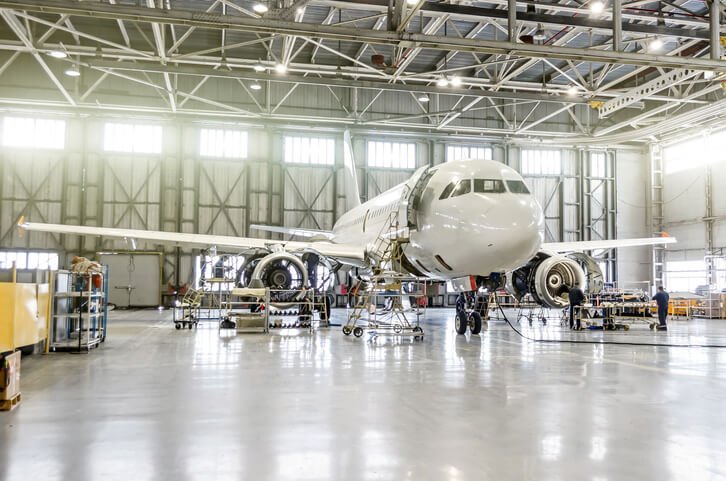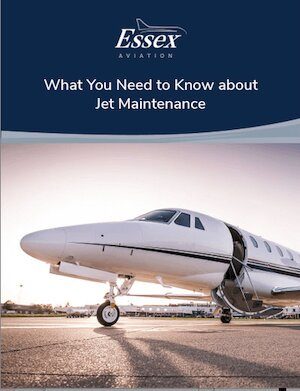
Like any mechanical piece of equipment, business aircraft must undergo routine maintenance in order to ensure proper operation and airworthiness. To that end, most private jets strictly adhere to a maintenance timeline: a series of inspections based on age and utilization as outlined by the Federal Aviation Administration (FAA), the aircraft manufacturer and other governing bodies.
In this beginner’s guide to jet maintenance, we’ll provide a high-level look at those timelines, as well as the various elements that go into keeping an aircraft in peak operating condition.
Key Terminology
Let’s begin by covering some general terminology useful to both engine and airframe inspections:
- Life-limited Parts (LLPs): An LLP is “any part for which a mandatory replacement limit is specified in the type design, the Instructions for Continued Airworthiness, or the maintenance manual.” Generally, LLPs are tracked by total time (hours) in service, or by the total number of cycles (or aircraft landings) accumulated. As would be expected, an LLP is often associated with an environment of heat or stress, such as within an engine; although an LLP may appear to be in good condition, it must be removed from service at its prescribed interval.
- Maintenance Repair and Overhaul (MRO): The airline industry uses the term MRO to identify a maintenance service company. With private aircraft in the U.S., the term is typically used to refer to larger, full service aircraft maintenance providers. Depending on the aircraft in question and the inspection requirements, there are multiple maintenance facilities that might not be formally recognized or referred to as MROs but are still fully capable to perform inspections and repairs.
- Major Repairs: According to the FAA, a major repair is any repair “that, if improperly done, might appreciably affect weight, balance, structural strength, performance, powerplant operation, flight characteristics, or other qualities affecting airworthiness” or “that is not done according to accepted practices or cannot be done by elementary operations.” Major repairs are typically required following an event in which an aircraft is damaged. Note: In cases where major repairs are administered, it is important to be aware whether timeframes between inspections that were originally assigned to the repaired area have been reduced.
- On Condition: Over the past few decades, a significant number of components, including turbine engines, have been approved to operate “On Condition.” Many airframe parts are visually inspected at certain intervals but, generally, one can assume that as long as a component operates correctly, isn’t leaking fluid, isn’t corroded and so on, it can continue in service On Condition. A turbine engine that is considered On Condition utilizes two primary data sources to ensure the engine is in good condition:
- Trend monitoring, which is a sophisticated means of measuring changes in engine performance by way of indications; and
- Borescope inspections, in which a technician utilizes video equipment to determine the internal condition of an engine without invasive engine disassembly.
- Note that the requirements of LLPs remain in full effect regardless whether an aircraft or engine utilizes On Condition tracking for maintenance or inspections.
- Time Between Overhauls (TBO): As its name implies, a TBO is the time period recommended by an aircraft manufacturer before an engine or other component requires overhaul. Two major components that come to mind when thinking of TBO are landing gear and engines. That said, there are normally many components associated with the aircraft that have prescribed TBO, which is typically tracked by hours, landings or calendar time.
- Supplemental Type Certificates (STCs): An STC is essentially an FAA-approved modification to an aircraft. When it comes to ongoing aircraft maintenance, it is important to ensure that any ongoing maintenance requirements related to an STC are followed. These requirements are known as Instructions for Continued Awareness (ICAs) and are included within STC records. ICAs are critical because they hold equal importance to the aircraft’s maintenance manual during inspections.
- Wear and Tear Repairs: Wear and tear repairs refer to any basic service necessary to repair damage resulting from expected normal and regular use. Such wear and tear often includes everything from cosmetic damage (chipped paint, oil streaks and so on) to areas such as the aircraft’s tires, brakes, control cables and windows. Regarding turbine engines, it is also helpful to know some basic terminology:
- Core Zone Inspection (CZI): A CZI is a term that applies to a major inspection interval on turbofan engines, typically used with Honeywell turbine engine models. CZIs are equivalent to an engine overhaul, which require certified engine maintenance providers to remove and completely disassemble and retest the engine.
- Hot Section Inspection (HSI): An HSI is also a significant engine inspection, one that examines the condition of limited engine components. HSIs primarily focus on the portion of a jet engine where high temperatures occur, including turbine discs, turbine blades and the combustion chamber. Similar to a Major Periodic Inspection (listed below), an HSI is often scheduled at the midway point of a scheduled engine overhaul interval, or if the performance of an engine deteriorates.
- Jet Engine Overhaul: Depending on the engine manufacturer, different terminology is used to refer to an overhaul; for example, Honeywell uses the term CZI, while Rolls Royce prefers the term “Shop Visit.” Pratt and Whitney and GE generally use the term overhaul for this inspection task. Regardless which term is used, a jet engine overhaul is the most comprehensive scheduled inspection an engine undergoes. A jet engine overhaul requires the complete disassembly and reassembly of the engine, followed by a recertification and rigorous testing process in order to approve it for future service.
- Major Periodic Inspections (MPI): Like CZI, the term MPI is also uniquely used by Honeywell, which is a popular turbine engine manufacturer. However, the essence of this inspection is similar to that of an HSI and is normally required after accumulating 50% of the hours required prior to a scheduled CZI.
Why is Jet Maintenance Important?
Similar to an automobile, business aircraft experience wear and tear — but, in most cases, aircraft are subject to more severe conditions that require preventative maintenance, servicing, corrosion control and ongoing monitoring to ensure safety. These services are designed to ensure that all parts and components are serviceable at the time of flight, and that the engines and systems are operating at peak performance levels.
In addition to ensuring peak performance, regularly scheduled maintenance also:
- Helps prevent canceled flights due to parts and components failure
- Complies with regulations and standards imposed by relevant governing bodies
- Ensures passenger comfort and safety
- Extends the life of the aircraft
- Allows for a better overall ownership and flying experience
How Frequently Should Your Aircraft Undergo Maintenance?
As we mentioned at the top of this article, there are multiple contributors responsible for setting jet maintenance timelines to ensure that private aircraft receive necessary attention on a routine basis.
Chief among these governing bodies is the aircraft manufacturer, which will specify the appropriate inspection intervals and TBO depending on the make and model of the aircraft, as well as when it was built, calendar time, the total number of hours flown and the total number of landings. In most cases, or unless safety concerns arise, the FAA will adopt the manufacturer’s inspection as an approved inspection program for that aircraft. To that end, private aircraft owners are advised to consult the manufacturer’s inspection guide for their particular make and model of aircraft; these should be made readily available to the owner at point of purchase but are otherwise available upon request.
Generally speaking, for corporate aircraft, six years between major maintenance events is common; likewise, 5,000 landings is often a major milestone for the aircraft’s landing gear to be overhauled. Finally, 1,200 and 2,400 hours flown are generally considered significant flight time intervals and would also require more invasive inspections. Emerging technologies, such as real-time engine monitoring services, make it easier for operators to assess when aircraft might need maintenance before its prescribed or scheduled timelines.
As previously mentioned, the FAA normally defers to the manufacturer’s recommended guidelines for maintenance timelines and requirements. It’s important to note that the FAA’s regulations and maintenance requirements only regulate those aircraft registered in the U.S.; other countries have their own regulatory authorities, so it’s in a private aircraft owner’s best interest to consult the relevant authorities when following an approved maintenance schedule.
How Much Does Private Jet Maintenance Cost?
There is no easy answer to the question of how much jet maintenance costs. Similar to a manufacturer’s unique maintenance guidelines, maintenance costs are dependent upon a number of factors — calendar time, the total number of hours flown and the total number of landings, in particular, dictate whether an aircraft requires routine maintenance or possibly major overhauls and repairs.
There are two ways to approach private jet maintenance costs: The first is a pay-as-you-go option, which enables owners to forecast costs based on the age of their aircraft and current and prior usage. The second is to enroll in various maintenance programs. While maintenance programs do vary, you pay an hourly rate, which is invoiced monthly; this hourly rate covers a determined and defined level of maintenance, much like a warranty. Most new aircraft come with an optional manufacturer’s maintenance program, and pre-owned aircraft can generally be enrolled in either a manufacturer’s program or third-party program.
Whether you choose to pursue a pay-as-you-go approach or pay into a maintenance program is entirely dependent upon your unique desire and requirements. With that said, it is generally advisable to enroll engines in a maintenance program because it can protect owners from exposure to high emergency repair costs.
Certain engine maintenance programs might also come in handy for routine engine repairs and maintenance. Jet engine overhauls — which are infrequent — generally last between 60 and 90 days. During this time, the MRO can provide the aircraft owner with a loaner engine for a per-hour cost based on the engine model. Jet engine maintenance programs typically cover the cost of access to a loaner engine but, rather than pay a standard rental fee, the owner might only be responsible for the direct operating cost per hours used of the loaner engine when enrolled in a maintenance program.
Who Should Maintain Your Aircraft?
Where you should take your aircraft for jet maintenance is entirely dependent upon the availability of a service provider recognized for high quality service on your particular aircraft model. Manufacturers generally offer some sort of warranty for newer aircraft, so, if you’ve acquired a new aircraft, it might make the most sense to bring it to a manufacturer-approved service center for MRO.
For older aircraft, we often advise our clients to look for specialty shops with experience working with their particular model aircraft, especially if it is a “classic” (that is, no longer in current production). These facilities do not need to be approved by the manufacturer, however, they must be FAA-approved. Although you could, technically, still bring an older model aircraft to a manufacturer-approved facility for service, there’s the chance that the manufacturer will be constrained from offering beneficial options. These options may include repairing a component (as opposed to replacing it) and utilizing approved aftermarket or serviceable products that could provide considerable cost-saving advantages.
For minor inspections and general maintenance, it’s best to look for local maintenance providers because the expense of flying your aircraft to a shop that’s geographically distant could outweigh the cost of the actual maintenance event. That said, it’s important that the capability of the local facility align with the complexity of the work needed. For example, if you’ve scheduled an inspection to coincide with interior or paint work, it is in your best interest to look for a single facility that can perform all of these tasks rather than go to multiple shops. An exception to both of these recommendations is, of course, the need for jet engine repairs. Jet engine repairs might involve complex activities that require the engine to be removed from the aircraft and delivered to a separate facility for necessary repairs.
Before selecting a maintenance provider, we recommend that you secure at least three separate bids from appropriate MROs. If you need a milestone inspection, you’ll want to ensure that any shops bidding on the project have the necessary tooling and labor resources to get the job done. A private aviation consultant is a valuable asset when evaluating bids from different jet maintenance providers because they can leverage their industry experience to help you identify which one best meets your particular maintenance requirements.
Find a Qualified Private Jet Maintenance Provider with Essex Aviation
When it comes finding the right jet maintenance provider, the experts at Essex Aviation are your most trusted allies. We will:
- Evaluate different facilities according to your customized needs, using our vast network of industry connections to assess the capabilities of different service centers
- Qualify various shops and identify which is the most capable based on the requirements of the job, including the warranty they provide for their work
- Provide onsite services during inspections to advocate for your interests and ensure that the best solution is selected
- Filter approvals and determine which ones deserve your attention
- Validate charges based on whether they’re true, accurate or even necessary
- Finalize and review return-to-service paperwork to ensure that all entries, part numbers, serial numbers, work completed and so on are accurate before they’re entered into your log books or permanent records
- Identify and rectify any discrepancies in paperwork and track down any missing documentation in order to protect the future value of your aircraft
As you can see, Essex Aviation is prepared to be your representative throughout the entire private jet maintenance process — and with over 70 years of combined aviation industry experience, we have the necessary skills and expertise to see the job through and ensure that it’s done right, the first time.
How can Essex Aviation help you? Contact us today to find out.







